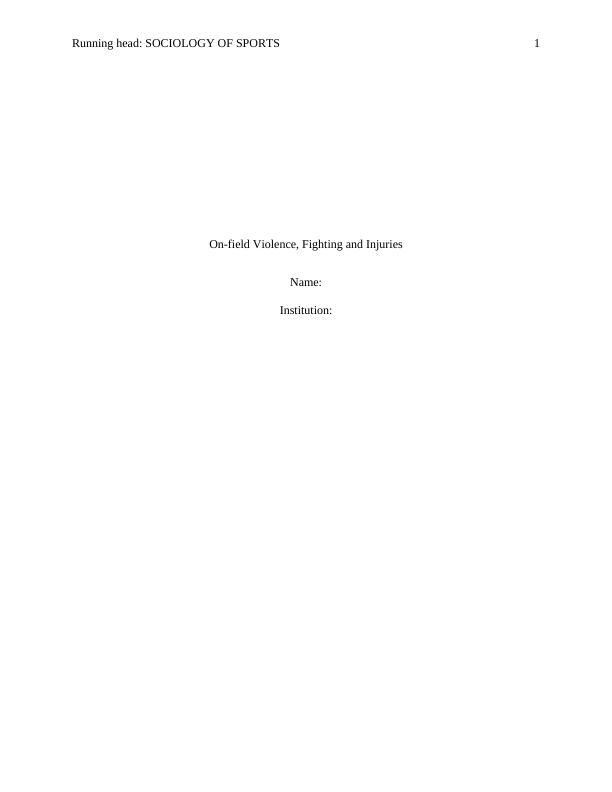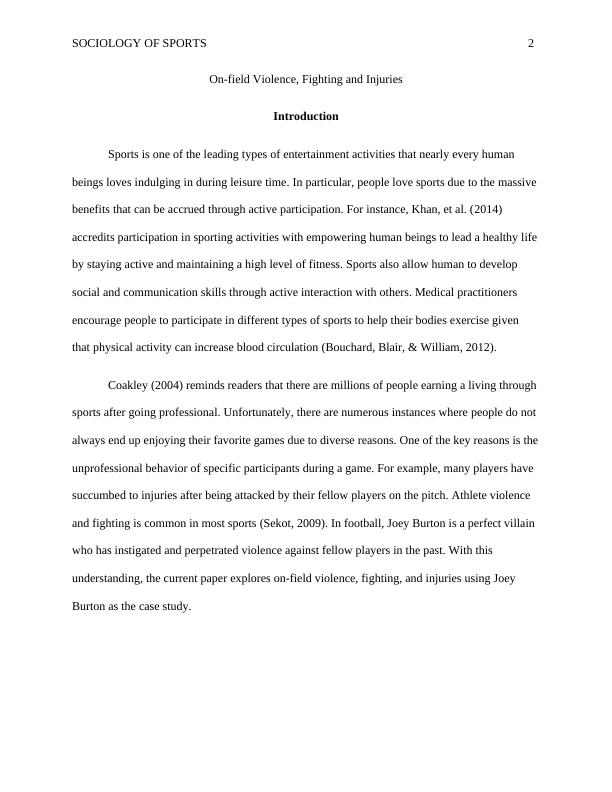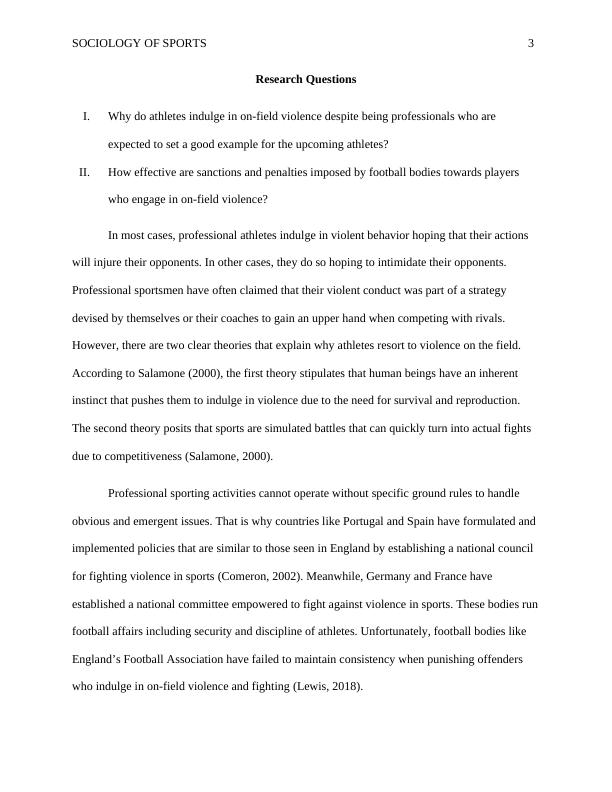On-field Violence, Fighting and Injuries in Sports: A Sociology Perspective
Added on 2023-06-08
8 Pages1889 Words349 Views
Running head: SOCIOLOGY OF SPORTS 1
On-field Violence, Fighting and Injuries
Name:
Institution:
On-field Violence, Fighting and Injuries
Name:
Institution:

SOCIOLOGY OF SPORTS 2
On-field Violence, Fighting and Injuries
Introduction
Sports is one of the leading types of entertainment activities that nearly every human
beings loves indulging in during leisure time. In particular, people love sports due to the massive
benefits that can be accrued through active participation. For instance, Khan, et al. (2014)
accredits participation in sporting activities with empowering human beings to lead a healthy life
by staying active and maintaining a high level of fitness. Sports also allow human to develop
social and communication skills through active interaction with others. Medical practitioners
encourage people to participate in different types of sports to help their bodies exercise given
that physical activity can increase blood circulation (Bouchard, Blair, & William, 2012).
Coakley (2004) reminds readers that there are millions of people earning a living through
sports after going professional. Unfortunately, there are numerous instances where people do not
always end up enjoying their favorite games due to diverse reasons. One of the key reasons is the
unprofessional behavior of specific participants during a game. For example, many players have
succumbed to injuries after being attacked by their fellow players on the pitch. Athlete violence
and fighting is common in most sports (Sekot, 2009). In football, Joey Burton is a perfect villain
who has instigated and perpetrated violence against fellow players in the past. With this
understanding, the current paper explores on-field violence, fighting, and injuries using Joey
Burton as the case study.
On-field Violence, Fighting and Injuries
Introduction
Sports is one of the leading types of entertainment activities that nearly every human
beings loves indulging in during leisure time. In particular, people love sports due to the massive
benefits that can be accrued through active participation. For instance, Khan, et al. (2014)
accredits participation in sporting activities with empowering human beings to lead a healthy life
by staying active and maintaining a high level of fitness. Sports also allow human to develop
social and communication skills through active interaction with others. Medical practitioners
encourage people to participate in different types of sports to help their bodies exercise given
that physical activity can increase blood circulation (Bouchard, Blair, & William, 2012).
Coakley (2004) reminds readers that there are millions of people earning a living through
sports after going professional. Unfortunately, there are numerous instances where people do not
always end up enjoying their favorite games due to diverse reasons. One of the key reasons is the
unprofessional behavior of specific participants during a game. For example, many players have
succumbed to injuries after being attacked by their fellow players on the pitch. Athlete violence
and fighting is common in most sports (Sekot, 2009). In football, Joey Burton is a perfect villain
who has instigated and perpetrated violence against fellow players in the past. With this
understanding, the current paper explores on-field violence, fighting, and injuries using Joey
Burton as the case study.

SOCIOLOGY OF SPORTS 3
Research Questions
I. Why do athletes indulge in on-field violence despite being professionals who are
expected to set a good example for the upcoming athletes?
II. How effective are sanctions and penalties imposed by football bodies towards players
who engage in on-field violence?
In most cases, professional athletes indulge in violent behavior hoping that their actions
will injure their opponents. In other cases, they do so hoping to intimidate their opponents.
Professional sportsmen have often claimed that their violent conduct was part of a strategy
devised by themselves or their coaches to gain an upper hand when competing with rivals.
However, there are two clear theories that explain why athletes resort to violence on the field.
According to Salamone (2000), the first theory stipulates that human beings have an inherent
instinct that pushes them to indulge in violence due to the need for survival and reproduction.
The second theory posits that sports are simulated battles that can quickly turn into actual fights
due to competitiveness (Salamone, 2000).
Professional sporting activities cannot operate without specific ground rules to handle
obvious and emergent issues. That is why countries like Portugal and Spain have formulated and
implemented policies that are similar to those seen in England by establishing a national council
for fighting violence in sports (Comeron, 2002). Meanwhile, Germany and France have
established a national committee empowered to fight against violence in sports. These bodies run
football affairs including security and discipline of athletes. Unfortunately, football bodies like
England’s Football Association have failed to maintain consistency when punishing offenders
who indulge in on-field violence and fighting (Lewis, 2018).
Research Questions
I. Why do athletes indulge in on-field violence despite being professionals who are
expected to set a good example for the upcoming athletes?
II. How effective are sanctions and penalties imposed by football bodies towards players
who engage in on-field violence?
In most cases, professional athletes indulge in violent behavior hoping that their actions
will injure their opponents. In other cases, they do so hoping to intimidate their opponents.
Professional sportsmen have often claimed that their violent conduct was part of a strategy
devised by themselves or their coaches to gain an upper hand when competing with rivals.
However, there are two clear theories that explain why athletes resort to violence on the field.
According to Salamone (2000), the first theory stipulates that human beings have an inherent
instinct that pushes them to indulge in violence due to the need for survival and reproduction.
The second theory posits that sports are simulated battles that can quickly turn into actual fights
due to competitiveness (Salamone, 2000).
Professional sporting activities cannot operate without specific ground rules to handle
obvious and emergent issues. That is why countries like Portugal and Spain have formulated and
implemented policies that are similar to those seen in England by establishing a national council
for fighting violence in sports (Comeron, 2002). Meanwhile, Germany and France have
established a national committee empowered to fight against violence in sports. These bodies run
football affairs including security and discipline of athletes. Unfortunately, football bodies like
England’s Football Association have failed to maintain consistency when punishing offenders
who indulge in on-field violence and fighting (Lewis, 2018).

End of preview
Want to access all the pages? Upload your documents or become a member.
